Artists
Streetwise: Artist Peter Doig on the Thrilling Show He’s Organized at Gagosian in New York
A Balthus borrowed from the Museum of Modern Art is at the heart of the exhibition, which unites canonical and obscure figures.
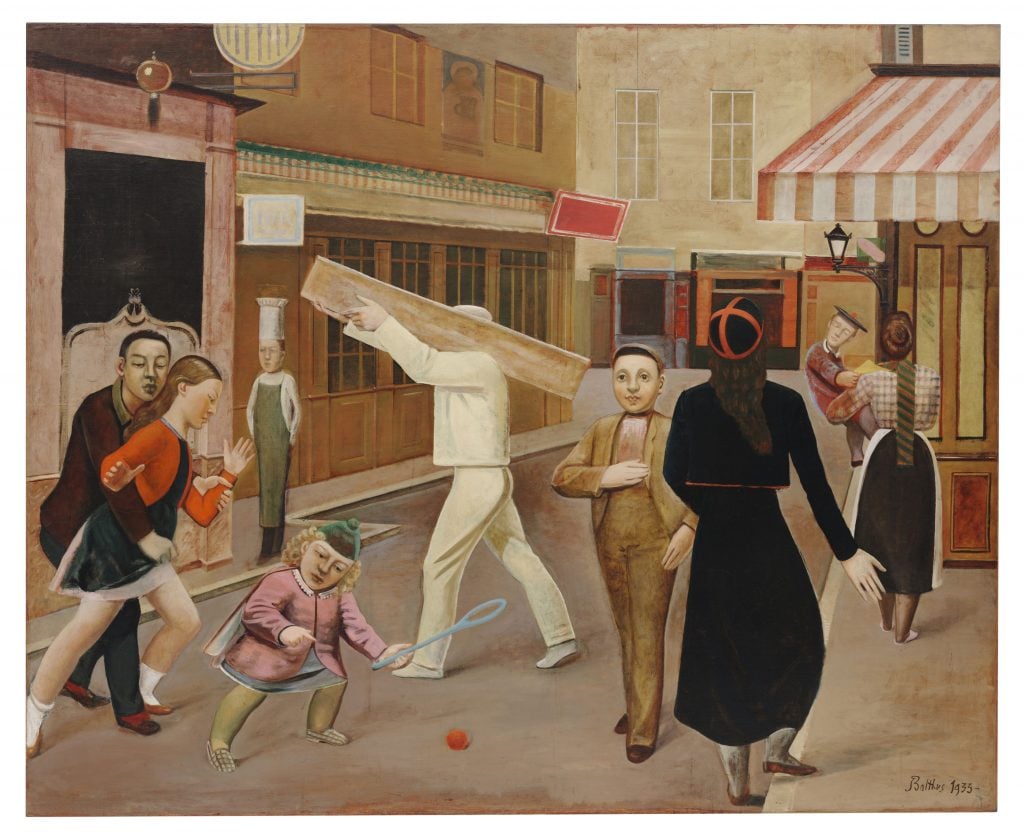
When the art dealer Larry Gagosian asked Peter Doig if he might be interested in doing something together, the famed painter responded with “a bit of a challenge,” Doig told me one recent afternoon. Would it be possible to borrow Balthus’s infamous 1933 painting The Street from the Museum of Modern Art? If so, he would organize a group show featuring the piece.
Doig was perched on a rolling chair in Gagosian’s Uptown Manhattan gallery as he relayed this a few weeks ago, and that astonishing painting was hanging on the wall in front of him. The show he ended up assembling was almost complete. Art handlers were awaiting a few more deliveries, and Doig’s wife, Parinaz Mogadassi, who runs the cloak-and-dagger gallery Tramps, was taking in the exhibition, as was Hans Ulrich Obrist, the artistic director of the Serpentine Galleries in London, where the artist will show next year.
The Balthus is strange and unsettling, a Paris scene with nine figures, each lost in their own psychic world. A man in white carries a plank through its center, a besuited boy marches toward us, and a chef (a mannequin?) wearing a toque stands sentinel in the distance. Balthus made it “during Surrealism,” Doig told me, almost whispering. “He’s not really a Surrealist, but maybe he’s more surreal than a Surrealist.”
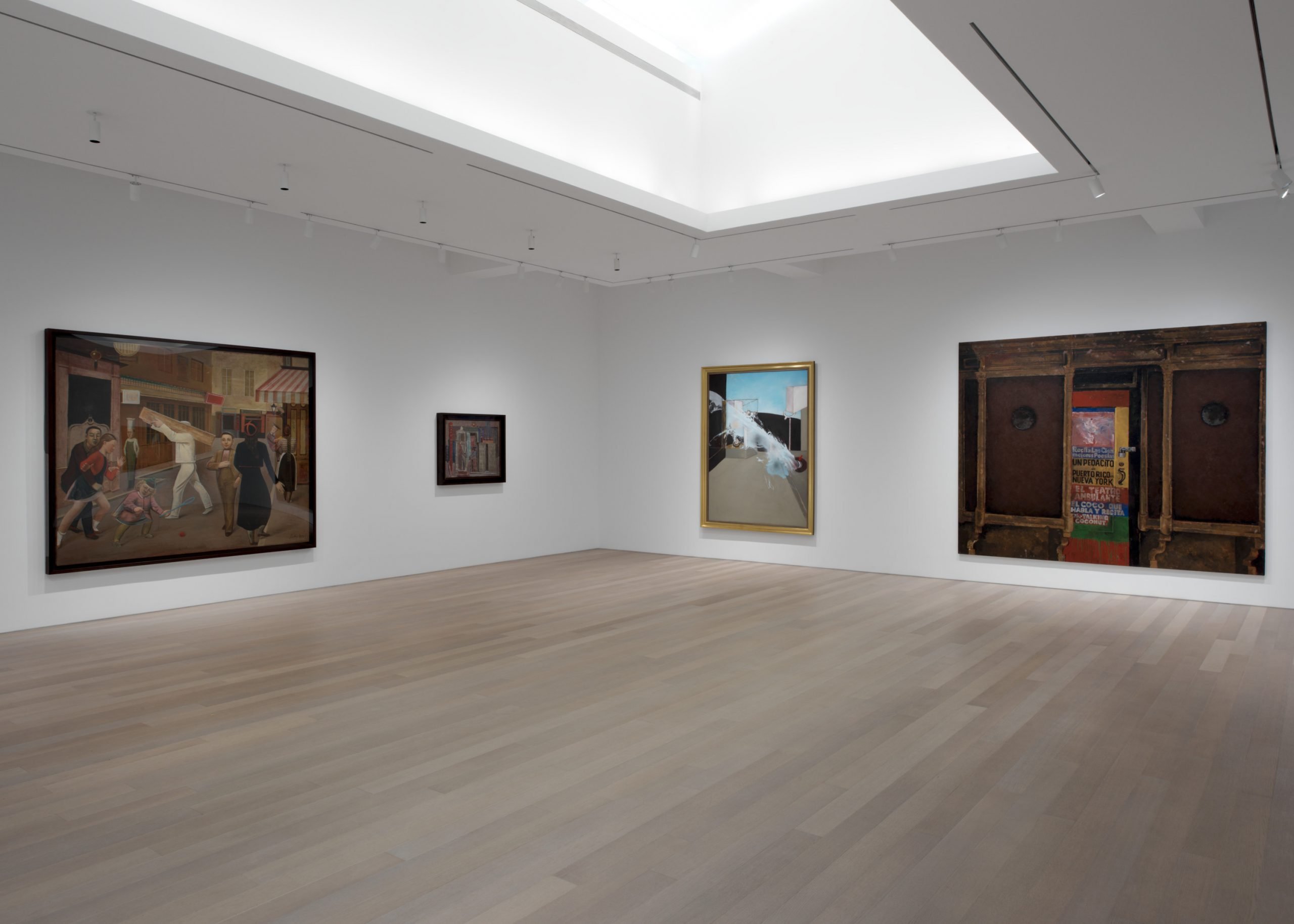
An installation view of “The Street” at Gagosian in New York with the Balthus, a Mark Rothko from around 1936, a 1988 Francis Bacon, and a 1986 Martin Wong. Artwork © 2024 Balthus/Artists Rights Society (ARS), New York/ADAGP, Paris; © 1998 Kate Rothko Prizel & Christopher Rothko/Artists Rights Society (ARS), New York; © The Estate of Francis Bacon. All rights reserved./DACS, London/ARS, NY 2024; © Martin Wong Foundation. Photo: Maris Hutchinson Courtesy Gagosian
The Street provides the title and the center of gravity for Doig’s exhibition, which has about two-dozen works by 17 artists—giants of the past century, like Mark Rothko, Vija Celmins, and Doig himself, as well as key lesser-known names (Prunella Clough) and emerging ones (Lotte Maiwald). While most of the pieces offer slices of urban life, that is really just a unifying conceit, a springboard for far greater ambitions. The show imparts the heady sense you get when listening to an artist riff on their inspirations, elucidating minute details and uncorking stories. It is the most thrilling group exhibition in town right now, and you have until December 18 to see it.
It’s a coup for Gagosian, as well as a show of force. Doig, who is 65, parted with his longtime representative, the Michael Werner Gallery (which is located around the block), last year, and has been working independently. He could exhibit anywhere. His enigmatic figurative paintings are coveted by both rich collectors—one traded for $39.9 million in 2021—and esteemed curators. In late 2023, he displayed some at the Musée d’Orsay in Paris alongside works he selected from its collection by Courbet, Gauguin, and others. Gagosian enjoyed that effort, paving the way for the current show. (The two men are in discussions about additional projects.)
Doig has a hard-to-place accent, the result of living all over, and he speaks quickly but carefully. He was born in Edinburgh, Scotland, and his family moved in his youth to Trinidad, then Canada. London is home these days, but he and Mogadassi also have places in New York and Trinidad, where Doig resided from 2002 to 2021. Some of his most satisfying paintings depict, in a lucid, partially impressionistic style, beaches, seas, and islands that seem to be full of secrets. You can detect in these works, which Doig often begins from photographs, embedded references to countless other artworks and images. Profiling Doig for the New Yorker in 2017, Calvin Tomkins proposed that “he seems to remember every painting he has ever seen.” That is not really true, Doig told me, “but I think I have a good memory of what I like.”
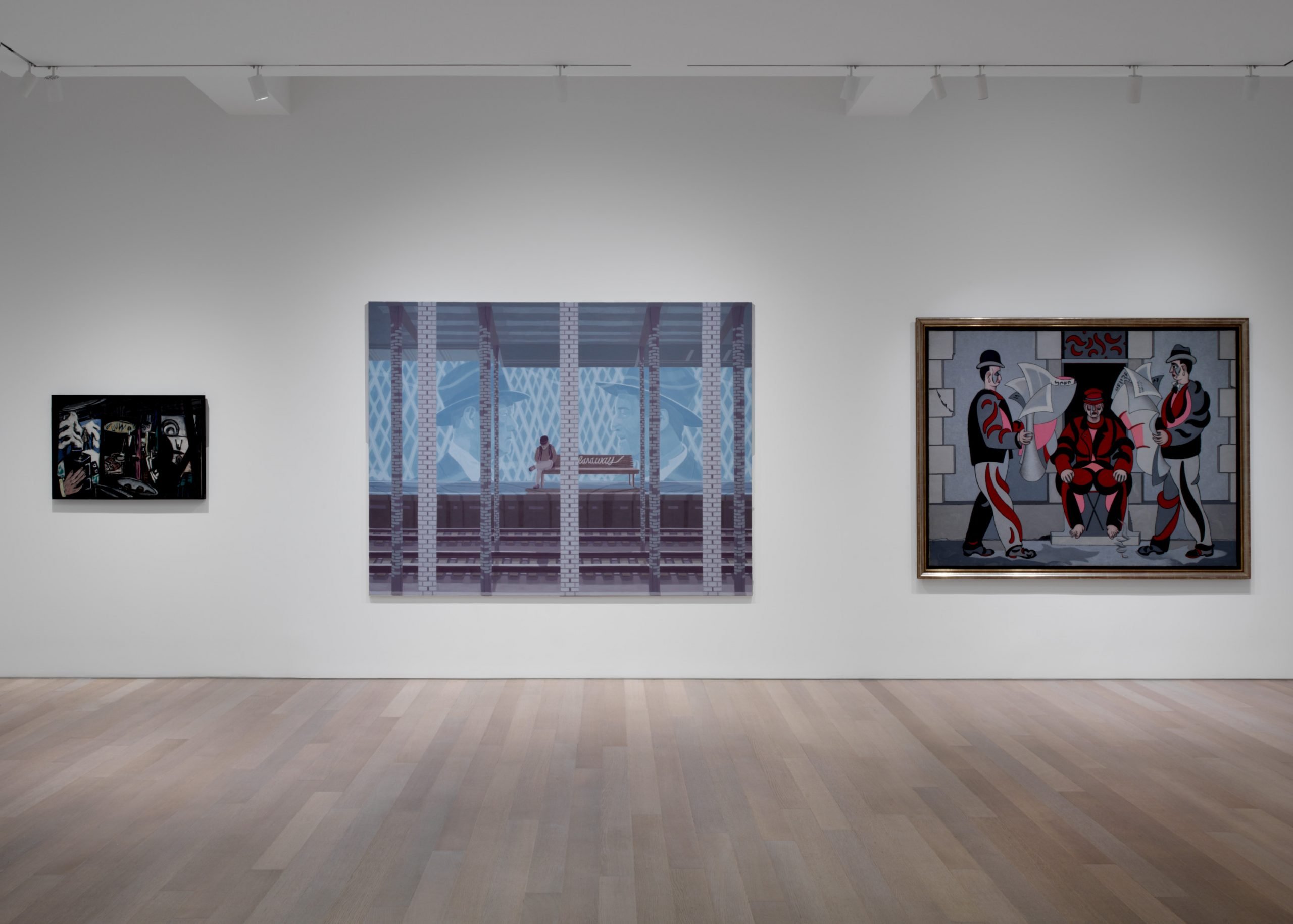
An installation view of “The Street” at Gagosian, with works by Max Beckmann (from 1933), Satoshi Kojima (2024), and Jean Hélion (1948). Artwork © 2024 Artists Rights Society (ARS), New York; © Satoshi Kojima; © Estate of Jean Hélion / Artists Rights Society (ARS), New York/ADAGP, Paris. Photo by Maris Hutchinson, courtesy Gagosian
In “The Street,” art history is alive on a grand scale, but perhaps because of its eclectic, hierarchy-defying lineup, it manages to feel intimate and personal. Doig first encountered The Street in the late 1970s on a visit to New York. Balthus “made this when he was 24, probably a little bit older than the age I saw it,” he said. Soon after, he hunted down its setting in the French capital. Here, too, is a funeral scene by the great Denzil Forrester, from 1982, when both artists were London art students. There is also a swirling vision of mid-century Greenwich Village by Beauford Delaney, whose works Doig saw when visiting a friend’s house while growing up in Toronto. (The friend’s father had been close to the artist.) “It’s just, to me, a magical view of the city at night,” he said.
The mood at Gagosian is by turns shadowy and spectral, lonely and charged. A solitary figure stands in a Giorgio de Chirico courtyard from 1912. A portrait of Arthur Rimbaud glows in a theater in a small, square canvas from 1975–76 by the late Frank Auerbach. Two classic 1980s Martin Wong paintings meticulously present Downtown storefronts, locked tight. “By any means necessary, he finds a way to describe the objects and make them believable,” Doig said.
A curious patch of gestural abstraction on a 1986 Wong (owned by KAWS) echoes a wild splash of paint on the 1988 Francis Bacon next to it, Doig noted. “In some ways,” he said, “the show could also be called Painters Making Paintings. This is what painters do, you know?”
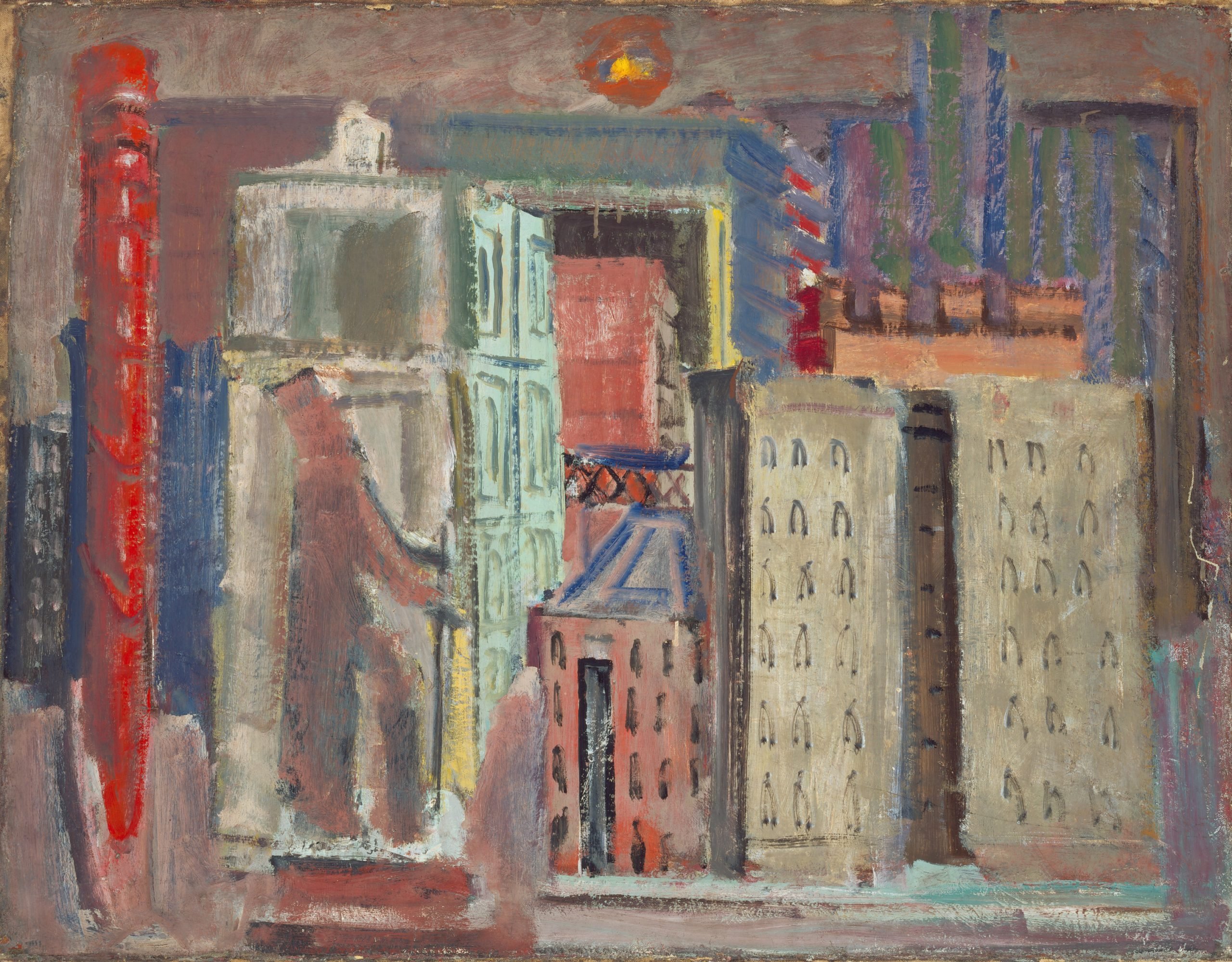
Mark Rothko, Untitled, ca 1936. Oil on canvas, 28 x 36 in. Collection of Christopher Rothko. © 1998 Kate Rothko Prizel and Christopher Rothko/Artists Rights Society (ARS), New York Photo: Art Resource, New York
Can we learn anything about Doig’s own paintings from his show? Maybe. Popping out of his chair, he passed near a gritty skyline that Rothko painted in his early 30s and stood in front of a painting by the Frenchman Jean Hélion (1904–87), who is relatively obscure stateside, but whom “to me is a major figure,” he said. It is cartoony and sinister. A stern man sits barefoot at a building’s entrance, flanked by two men reading newspapers. “It’s just one of those paintings that’s full of decisions that you can’t really work out,” Doig said, pointing out the lines of the men’s jackets—hard-edged at a glance but actually oddly “furry.”
“Being a French painter, post Picasso, Matisse, the world of French painting, Léger—where do you go?” he asked of Hélion, who started as an abstractionist. Doig himself came of age at a fraught moment for painting. One segment of the art world was declaring it passé in the 1980s, while hard-living Neo-Expressionists were dominating another segment. He made his own sometimes-inscrutable decisions, drawing on distant forebears like Klimt, Beckmann, and Kirchner. His moody landscapes and portraits are steeped in history but still manage to feel of the present moment, art born of a noble and productive conservatism.
What has stuck with me most about Doig’s exhibition is the pervasive suggestion of violence within it, which is sometimes hinted at, sometimes bluntly delivered. In the Balthus, a young man (or a boy?) is trying to grab hold of a girl. “I have six daughters, and you worry every time we go up the street,” Doig said. “I worry about my sons, too.” Then there are Wong’s barred storefronts, Forrester’s vivid portrayal of a Black man in coffin, Winston Rose, who was killed by the police, and in a 1937–38 Beckmann, “this horrendous, sort of despicable, sort of horror, torture,” Doig said. “It’s kind of like his Guernica, but it’s almost like a crazier Guernica.” Vicious birds terrorize humans, and one slashes the back of a man with a knife. (It was the first painting that Beckmann made after fleeing Germany for Amsterdam, Doig said.) In this atmosphere, even Celmins’s deadpan 1964 painting of a space heater exudes dread.
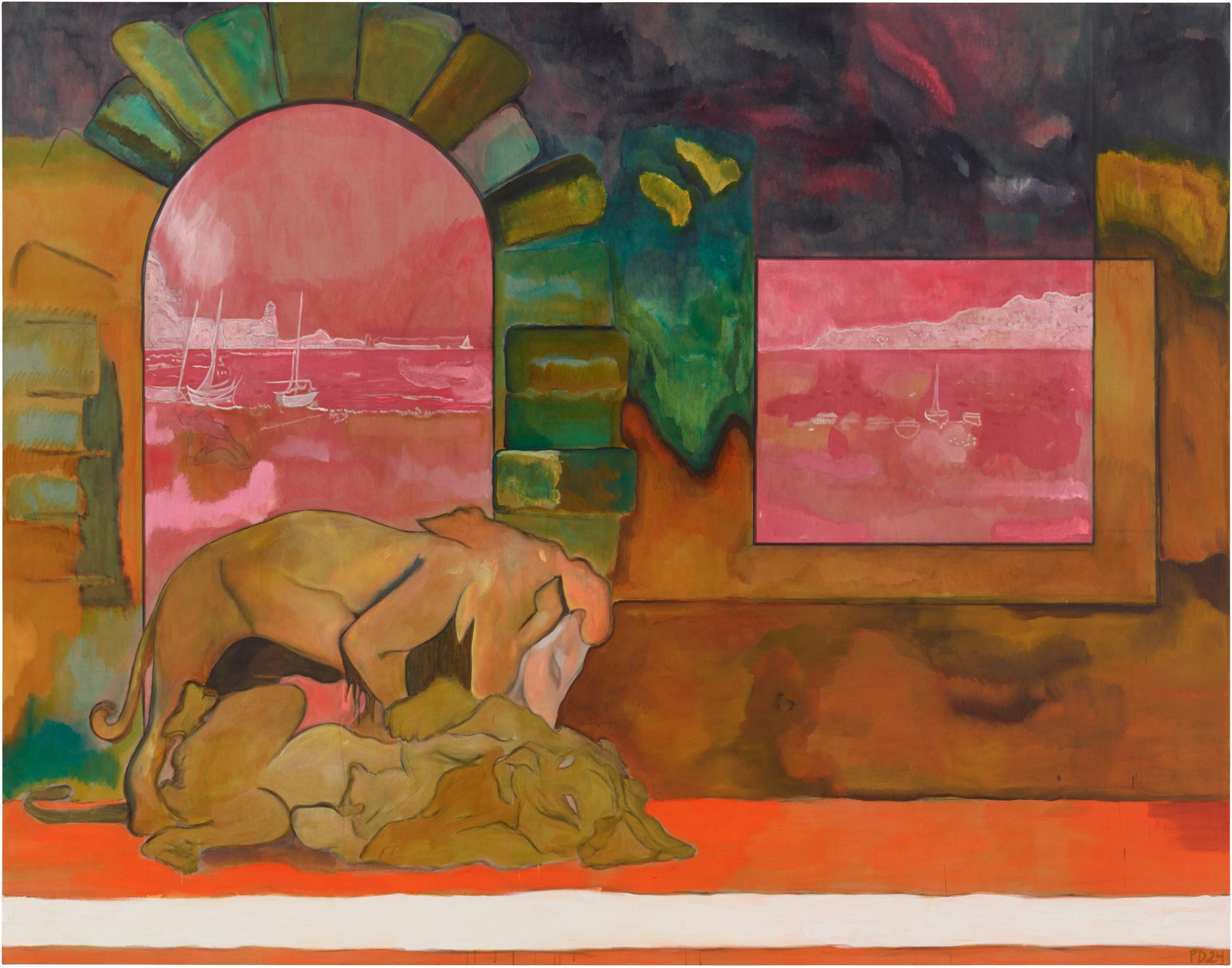
Peter Doig, Lions (Ghost), 2024. Oil on canvas, 108 1/4 x 137 3/4 in. © Peter Doig. All rights reserved. Courtesy the artist and Gagosian
A single new Doig painting has found its way into the show, an 11 ½-foot-wide seaside in smoldering Fauvist color, and the violence in it is almost undetectable. True, two lions (a favorite symbol for the artist) are having “a playful kind of wrestling match,” as he said, but they seem peaceful. Look through the old stone doorway behind them, though, and out on the pink sands, a murder is taking place. One man is holding down another, as in Caravaggio’s Beheading of Saint John the Baptist (1608), which Doig saw at St. John’s Co-Cathedral in Valletta, Malta. Potent beauty harbors death.
The artist kept pausing as he discussed the work, trying to find the right words. “It’s a very new painting for me, so I don’t…” He trailed off. “I find it still sort of refreshing,” he said. “I’d like to do another one.” (In a separate space, there are 11 studies for the piece, including a large rendition of the killing, which are alone worth the trip to 980 Madison.)
There is also a much earlier Doig painting here, one that he just tracked down after not seeing it for more than 25 years. It’s called Night Playground (1997–98), and it shows teenagers roaming inside a fenced park. One may be getting bullied. It began as a blurry photo that Doig shot in New York while in a car en route to the airport. It is rougher and denser in texture than his more recent work. “It’s funny seeing it,” he said. “I don’t think I’d ever make a painting like this. I look at it now, and, you know—all these funny choices.”
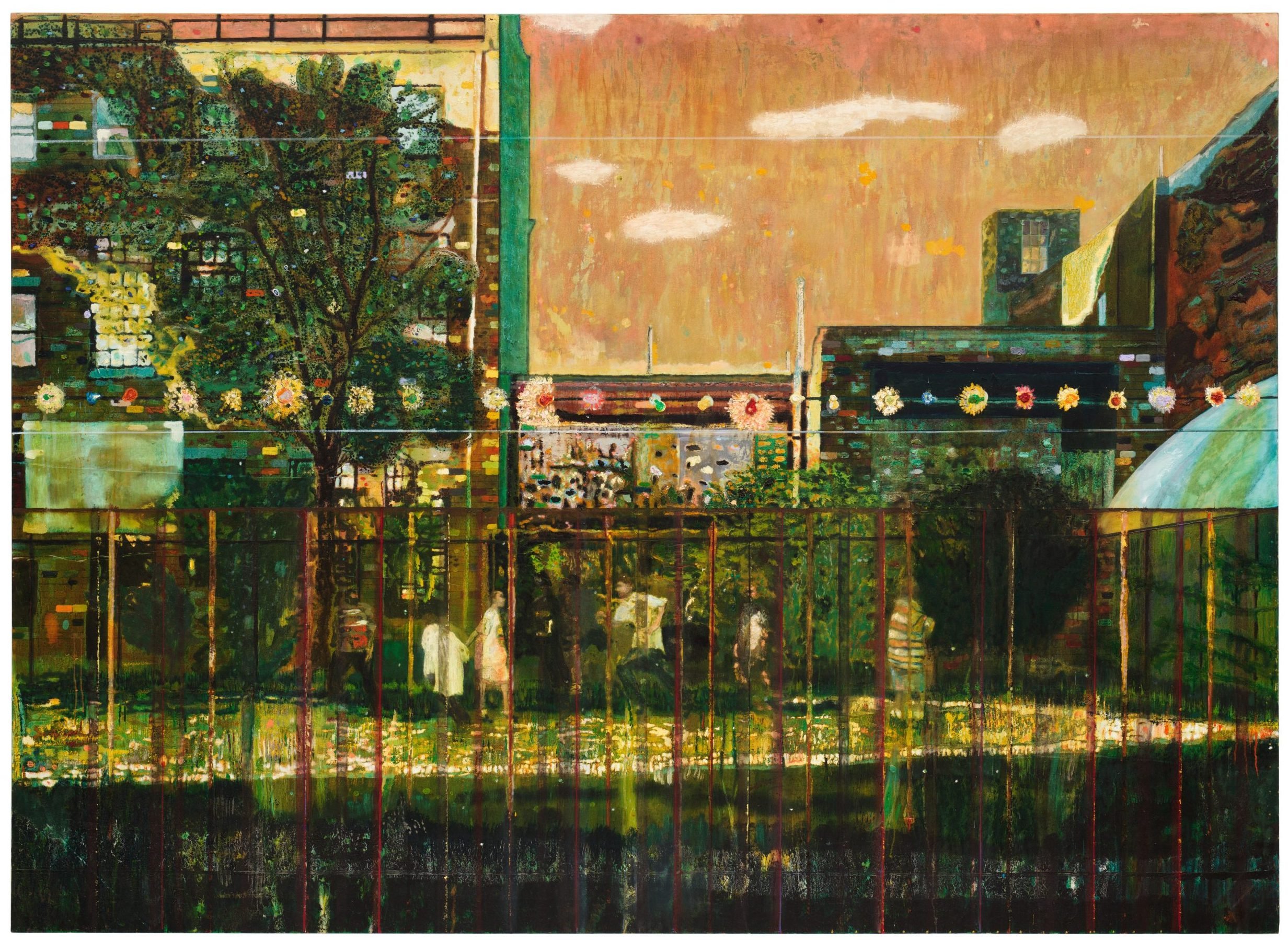
Peter Doig, Night Playground, 1997–98. Oil on canvas, 78 3/4 x 108 in. Lent by Ananda Foundation N.V. © Peter Doig. All rights reserved. Photo by Maris Hutchinson, courtesy Gagosian
Tiny dots flutter across its surface, delineating various elements. That was once a trademark Doig technique, but he felt it was “becoming a mannerism, so I stopped doing it,” he said. He seemed pleasantly surprised by some of those marks now. “That’s not an ineffective way to make a tree, right?” he said.
As a curatorial enterprise, “The Street” is about “what painters do,” absolutely, but it is also about how they change over time—how they can mint wonders in their youth (Balthus!) and then perhaps slow down and shift in ways that even they may not fully understand. Rothko ventures into abstraction. Hélion heads in the other direction. They keep experimenting, following their intuition, trying to get it right. That’s art’s joyous, and melancholic, and painful promise.
As the interview wound down, we were in front of Doig’s playground painting, and he was examining different parts of it. “I guess I can look back at it now, and be a little bit sentimental about it,” he said, “and see it as being made by a younger me, and think, ‘Well, actually, it’s done. I did it.’”





